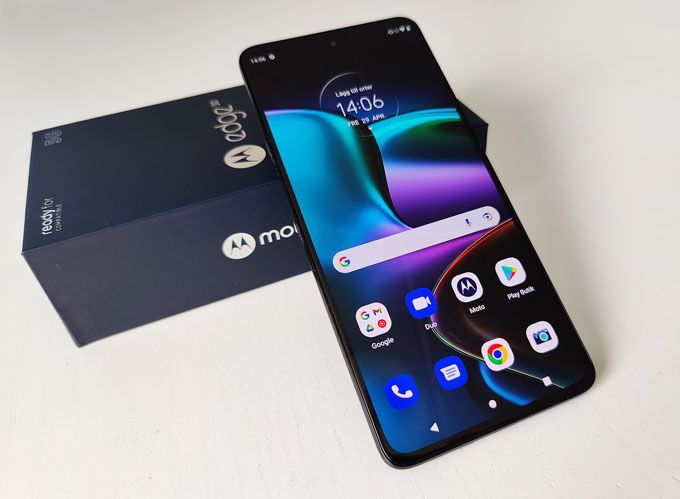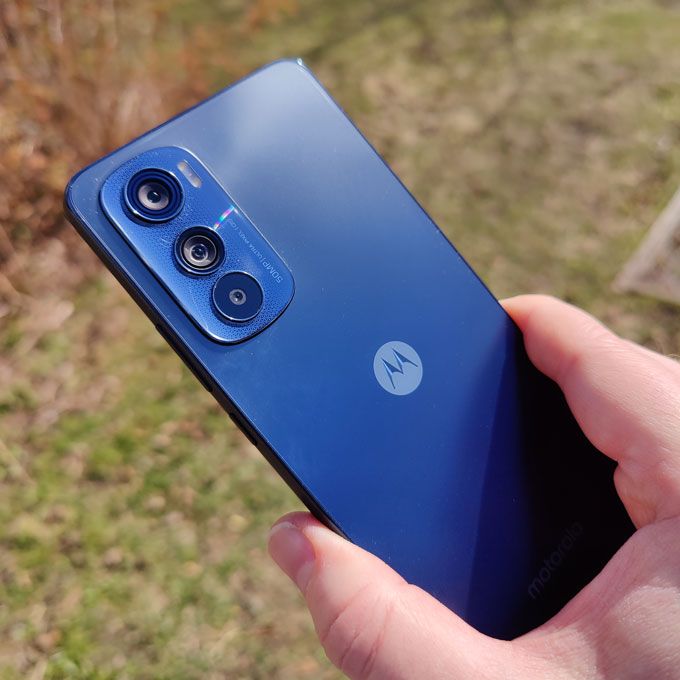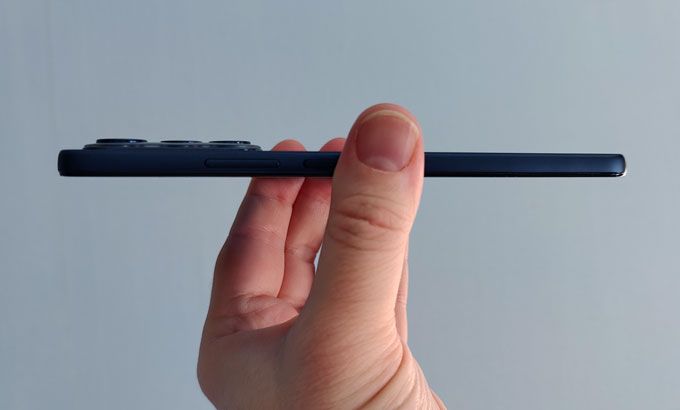Motorola is a manufacturer that is not shy about experimenting and trying new things. We remember their innovative Moto Z series a few years ago, with its flat back with interchangeable modules and the first Motorola Edge mobiles, which took the curved screen edge to a whole new level. The latest generations of the Edge have been good mobiles, but not as interesting. However, the Edge 30 stands out and is aimed at those who think that modern mobiles are too thick and heavy.
Rating 4.5 out of 5
Opinion
Edge 30 manages to be different without it becoming a gimmick. It is slim, elegant and well built. It generally has good cameras and performance that is sufficient for most things. It does not succeed one hundred percent with all its high ambitions, but as long as we remember that it actually has a price in the middle class, it is a really convincing phone.
Positively
- Good middle class performance
- Nice sharp screen
- Thin, light and well-built
- Competent, easy-to-use cameras
Negative
- Weaker graphics performance
- Not perfect for dark photography
- Ready For wireless only
This is a phone that is a step down on several points from the top model Edge 30 Pro. It does not have the most powerful processor, not as much memory, it has less screen, lower weight and smaller dimensions on all joints. Above all, it is unusually thin. Between two flat discs, glass on the front and matte plastic on the back, it is under seven millimeters. That should make it the thinnest 5g mobile ever, says Motorola. That is true, at least in Swedish stores. However, the camera body protrudes just over a millimeter, but that is largely unavoidable nowadays.
Edge 30 is also light for such a modern mobile, just over 150 grams. There are mainly three things that contribute to this. A smaller battery than many other top mobiles today. With just over 4,000 milliampere hours, where many have between 4,500 and 5,000. Lack of wireless charging, which otherwise often adds a few grams. And finally a frame in hard plastic instead of metal. It still has a high sense of quality and is durable, so we do not think it is a big minus.
Especially not because Edge mobiles do not belong to the class of overly expensive luxury mobiles. Edge 30 has a recommended price of SEK 4,999 for our tested model with 128 gigabytes of storage. There is a slightly more expensive model with 256 gigabytes of storage. Edge 30 should rather be seen as a competitor to other mid-range mobiles such as Oneplus Nord 2, Samsung Galaxy A53, Xiaomi 11 Lite NE and maybe Iphone SE.
Correct performance for the money
In that competition, it is doing very well. With Snapdragon 788 G + you get a lightning-fast experience in all everyday use, surfing heavy websites flows smoothly, demanding apps open quickly and can be used without major problems. There are faster mobiles in the price range, but also much slower.

It also goes through in details like compliant animations in the interface and a fast fingerprint reader. Occasional moments such as heavy image processing and switching between certain apps can cause mini-breaks, but overall it goes away. The exception is demanding Android games, which may need both more cpu and especially gpu. At that point, for example, Oneplus Nord 2 is much more powerful.
The Amoled screen is both sharp, colorful and bright. It supports hdr10 + for better movie experiences, and reaches 144 Hz frame rate. In the standard mode, it selects the frequency itself and it seems to do so with praise. It does not seem to go below 60 Hz, we do not think it is an ltpo2 panel, which so far is only available in a few of the most expensive mobiles on the market, so it is not surprising.
You get stereo speakers with a clear bass and plenty of details in the treble. What it lacks is volume strength. If we pull it up to the max, there is still a risk of being overwhelmed in noisy environments. At the highest volume, the middle register can also be a bit scary. But then we are in petitesser, this one generally sounds good.
Two large but fast sensors
The cameras on the back are three in number, the same as in the Edge 30 Pro. This means a 50-megapixel main camera, a 50-megapixel wide-angle camera that also captures macro images and a small depth sensor for portrait photography. It shoots just as well as the Edge 30 Pro. This means fast handling and reliable focus, plenty of details, fine dynamics, except in occasional extreme lighting conditions, and soft but steady image stabilization. At least as long as we stay away from the mode that takes high-resolution 50-megapixel photos.

The wide-angle camera is almost as high class, but can have occasional problems focusing on the periphery of images. It seems to be sensitive to movement. Edge 30 is average in dark photography, both with the main camera and the wide angle. It does not do away with itself, especially not in its price range, but it also does not stand out as excessively good. You can count on some noise and more patience with autofocus.
What you do not get, as you get in the Edge 30 Pro, is a high-resolution selfie camera. This is not the large 60-megapixel sensor that the Pro model has, but a respectable 32-megapixel sensor that takes sharp pictures with good skin tone.
Good battery life, after all
The Edge 30 has a battery of 4,020 mAh, which does not unexpectedly give it shorter battery life than other similar smartphones with batteries around 5,000 mAh. The Snapdragon 778 G + is relatively energy efficient and the screen keeps the power consumption at an approved level, even in the automatic frame rate mode.
But no, operating hours up to 24 hours, which some mobiles can be proud of, we do not get here. However, without problems, it lasts a longer working day and for the most part a normal full day of mixed use, if you do not have constant screen time.
The phone is charged with up to 35 watts of power via USB, with Motorola’s own Turbocharge technology. Almost half as efficient as the Edge 30 Pro, a phone with a smaller battery on the other hand. It takes us about an hour and 40 minutes from zero to 100 percent. As I said, you can do without a wireless charger, but this is not something we ask for in the middle class.

Android, and a little more
With Android 12 and Motorola’s My UX, which do not make major changes to the original interface, you get a pure Android experience, with just a few extra additions. With two years of Android updates and three years of security updates promised, Motorola gets approved, even if they are not the best in class.
There are then features in My UX that you can explore if you want or completely ignore. Perhaps the most noticeable is Ready For, an interface in either desktop or media center style, which can be activated on an external monitor.
The Edge 30 does not support display via the USB C port, so you can use it with a wireless connection to a Miracast-compatible display or TV. Unfortunately, it involves a certain lag, which we think makes it questionable for desk work, but as a media player for a TV, it works better. At least if you have fast and stable enough wifi at home.
With solid mid-range performance, sleek design, good screen, camera and speaker quality and fully acceptable battery life, even though the battery is relatively small, there’s a lot to like about the Edge 30. The step up to the Pro model is bigger in price than it is in quality. Motorola Edge 30 steps in as this year’s most interesting mobile so far in the SEK 5,000 class. Most interesting of the new phones anyway. There are still good competitors from last year who are in the urban battle.
Specifications
Product name: Motorola Edge 30
Tested: April 2022
Contact: Motorola
System circuit: Qualcomm Snapdragon 778G +
Processor: 1 pc Cortex-A78 2.5 GHz GHz + 3 pcs Cortex-A78 2.4 GHz + 4 pcs Cortex-A55 1.8 GHz
Graphics: Adreno 642L
Memory: 8 GB
Storage: 128 GB
Screen: 6.5 inches amoled, 1080×2400 pixels, 144 Hz
Cameras: 50 megapixels + 50 megapixels wide angle + depth sensor with LED rear, 32 megapixels front
Connections: Usb 2.0 typ c
Communication: 2g, 3g, 4g, 5g, wifi 6E, bluetooth 5.2, agps, galileo, nfc
Operating system: Android 12 with My UX
Other: Dual SIM, fingerprint reader, splashproof (IP52)
Battery: 4 020 mAh, 17 hours 50 min online video (wifi, high brightness, 60 Hz), approx. 14 hours mixed use (4g, low brightness, 144Hz), approx. 26 hours call
Battery charge: 33 W usb (TurboPower)
Size: 15.94 x 7.42 x 0.68 cm
Weight: 155 grams
Rec. Award: From SEK 4,999
The Motorola Edge 30 goes on sale May 9.
Performance
Antutu Benchmark: 602 271 points
Geekbench 5: 2,880 points
Geekbench 5 and core: 828 points
3dmark Wild Life: 2,849 points
Storage, reading: 1 603.2 MB / s
Storage, writing: 895.2 MB / s
.
[related_posts_by_tax taxonomies=”post_tag”]
The post Test: Motorola Edge 30 – slim mobile that convinces appeared first on Gamingsym.
